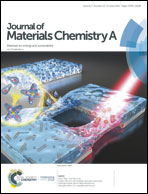Directly grown high-performance WO3 films by a novel one-step hydrothermal method with significantly improved stability for electrochromic applications†
Abstract
Currently, the electrochromic technology is still facing problems of high-cost and inadequate electrochromic performance. The WO3 film prepared by the conventional hydrothermal method usually needs a crystal seed layer to be prepared on the substrate, which incurs additional energy consumption and retards electron transport. This paper presents a novel idea of a one-step hydrothermal synthesis combining the self-seeded agent glycerol with the capping agent ammonium sulfate ((NH4)2SO4), which avoids the need for a complex preparation process and significantly enhances cyclic stability. Under the synergistic effect of the glycerol and (NH4)2SO4, the resultant hexagonal system WO3 (hex-WO3) film exhibited a novel “coral-like” nanostructure and showed excellent electrochromic properties: a fast switching time (6/5 s for bleaching/coloration), a good coloration efficiency (56.5 cm2 C−1), and a large optical modulation (∼78.1%) at 630 nm by applying ±1 V voltages. More importantly, the film obtained an outstanding cyclic stability (15 000 cycles without significant decay). Additionally, an electrochromic device (ECD) was successfully assembled, exhibiting fascinating performances, in which Prussian blue (iron(III) hexacyanoferrate(II), PB) was used as a complementary electrode.



 Please wait while we load your content...
Please wait while we load your content...